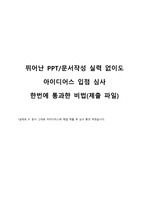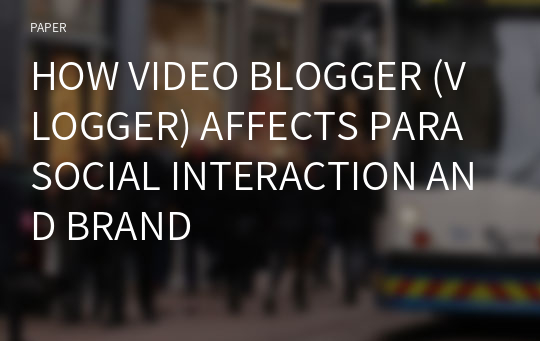HOW VIDEO BLOGGER (VLOGGER) AFFECTS PARASOCIAL INTERACTION AND BRAND
* 본 문서는 배포용으로 복사 및 편집이 불가합니다.
서지정보
ㆍ발행기관 : 글로벌지식마케팅경영학회(GFMC)
ㆍ수록지정보 : Global Marketing Conference
ㆍ저자명 : Matthew Tingchi Liu, Pamela Lam I Kei, Yongdan Liu, Ting-Hsiang Tseng
ㆍ저자명 : Matthew Tingchi Liu, Pamela Lam I Kei, Yongdan Liu, Ting-Hsiang Tseng
영어 초록
IntroductionSocial media continues to grow and presents in our everyday lives. Consumers can even know about celebrities’ personal lives and hear directly from celebrities through social media, such as Facebook and Instagram. Chung and Cho (2017) point out that social media provides a platform for a more open, close and frequent interaction between consumers and celebrities. According to Lee and Watkins (2016), by using social media, consumers can easily and quickly access user generated content which includes product information and reviews. People create video blog (vlog) and some have attracted a large number of followers, video bloggers (vloggers) upload videos about their personal life or reviews of product they use, therefore increasing browsing traffic from followers and other viewers. As a result, vloggers become vlog celebrities or key opinion leaders on social media nowadays. According to Horton and Wohl (1956), parasocial interaction (PSI) explains the relationship between media persona and media user, and it is referred to a media user’s reaction to a media persona, in a way that the media persona is perceived as an intimate conversational partner by the media user. The media persona may be considered by his/her audience as a friend, counselor, comforter and model, and PSI is considered as a “friendship” with a media persona (Perse & Rubin, 1989). As this “friendship” continues to grow, the media user will gradually treat the media persona as a trustworthy friend and rely on their suggestions as a trusted source of information (Rubin et al., 1985). According to Stever and Lawson (2013), PSI is an appropriate theoretical framework for studying the one-sided relationship between celebrities and fans; so the same argument can be extended to vlogger as suggested by Lee and Watkins (2016). As there is limited studies investigating the link between vlogger and marketing results in the literature, and researches examining the relationships between PSI and perceived brand quality, brand affect as well as brand preference are rare and lack empirical support, therefore, some research gaps need to be bridged. This study develops an integrated model according to the literature review. It is expected to help marketers to understand the influence of vlogger, and to develop efficient social media marketing tactics and branding strategies by using PSI as a brand management tool.
Literature review and hypothesis development
Parasocial interaction (PSI) explains the relationship between media persona and media user, and it is referred to a media user’s reaction to a media persona, in a way that the media persona is perceived as an intimate conversational partner by the media user. Previous studies indicate that PSI develops in ways similar to interpersonal relationships with friends (Horton & Wohl, 1956; Rubin & McHugh, 1987; Perse & Rubin, 1989), so the media persona may be considered by his/her audience as a friend, counselor, comforter and model, and PSI is considered as a “friendship” with a media persona (Perse & Rubin, 1989). Labrecque (2014) suggests that the development of PSI is not restricted to traditional media but also in an online environment. Labrecque (2014) points out that the higher the perceived level of openness and interaction in communication between consumers and brands on social media, the stronger their PSI with the brands. A direct relationship is also found to exist between social media interaction and parasocial behavior (Chung & Cho, 2017). Vloggers emerge as vlog celebrities or key opinion leaders who are active on social media, nowadays the media users can share their own thoughts with the celebrities and even comment the celebrities’ lives on Twitter, Facebook and Instagram freely, as if they have established a “friendship” with the celebrities (Chung & Cho, 2017), PSI is found to exist between vloggers and media users and is therefore fostered (Lee & Watkins, 2016). Attraction to a media persona results in enhancement of interaction or repeat viewing (Rubin & McHugh, 1987). If a person's physical appearance is considered to be aesthetically beautiful or pleasing, the degree of physical attractiveness is thus higher. Till and Busler (2000) suggest that physically attractive people are considered to possess more favorable personality traits such as intellectual competence, social competence and integrity. Both social and physical attractiveness to a media persona have been found to be predictors of PSI (Lee & Watkins, 2016; Perse & Rubin, 1989). This study thus postulates that: H1: The physical attractiveness of vlogger has a positive effect on PSI. Social attractiveness is referred to a media persona’s likability (McCroskey & McCain, 1974) and considering the media persona as a viable friend (Frederick et al., 2012). Media persona who is socially attractive leads to a stronger PSI, in both social and work context (Rubin & McHugh, 1987). Social attractiveness has been found to be a predictor of PSI (Lee & Watkins, 2016; Perse & Rubin, 1989). This study thus postulates that: H2: The social attractiveness of vlogger has a positive effect on PSI. According to Rubin and Step (2000), motivation is central to communication processes, and different motivations would lead to different behavior and communication choices. In the video sharing platform such as YouTube, YouTube users engage with YouTube for entertainment purposes (Haridakis & Hanson, 2009). Entertainment refers to any activities that provide diversions and amusements to fill time, gain pleasure, relax and have fun (Yuan et al., 2016). People not only watch vlogs for entertainment but are also widely influenced by the content of vlogs (Chung & Cho, 2017), as vloggers are viewed as more authentic and true-to-life (Lee & Watkins, 2016). This study postulates that: H3: Viewing motive with vlogger for entertainment has a positive effect on PSI. People use media not only for entertainment, but also for satisfying interpersonal needs (Armstrong & Rubin, 1989; Madianou & Miller, 2013; Rubin et al., 1985). As media user’s motivations for using media correlate with the development of PSI positively (Rubin et al., 1985) and the motivation of individuals to undertake relationship building by using social network service is found to be positivly correlated with parasocial behavior (Yuan et al., 2016), it is proposed that the more the media user’s motive to use social media involving vlog for relationship building, the stronger their PSI with vlogger. This study thus postulates that: H4: Viewing motive with vlogger for building relationship has a positive effect on PSI. More time spent with the medium encourages a participative and active culture, and higher online traffic implies more opportunities for online advertising and promotions (Hung et al., 2011). When media user is exposed with frequent messages enriched with personal information from a media persona, psychological familiarity and intimacy are enhanced, resulting in further development of friendship over time (Chung & Cho, 2017). This study thus postulates that: H5: The time spent with the medium has a positive effect on PSI.
Mediating effect of PSI
PSI explains the relationship between media user and media persona (Horton & Wohl, 1956) and is considered as a “friendship” with a media persona (Perse & Rubin, 1989). Previous study implicitly addresses the mediating role of PSI between the antecedents of PSI and brand perception (Lee & Watkins, 2016), however, the mediating role of PSI between the relationship of the antecedents of PSI and perceived brand quality, brand affect as well as brand preference has not been investigated. Specifically, PSI decreases uncertainty (Perse & Rubin, 1989) and consumer’s confidence has been shown to be a key component of forming positive perceived brand quality (Kayaman & Arasli, 2007). Moreover, social media strategies are often used to build positive brand attitude through enhanced consumer engagement and consumer likeability towards a brand, making brand affect metric relevant to social media marketers. Finally, Grimm (2005) suggests that attitude can predict preference and preference is influenced by emotional and personality responses to the brand. Feelings of bonding with brands are fostered by PSI, as a result positive brand attitude is enhanced (Knoll et al., 2015). Moreover, evidences show that celebrity endorsement can help to positively influence consumer’s brand preference (e.g. Kamins et al., 1989). Thus, it is predicted that PSI mediates the effects of the antecedents of PSI: physical attractiveness, social attractiveness, viewing motive for entertainment, view motive for building relationship and time spent with the medium on perceived brand quality, brand affect and brand preference, and has the following direct effects on perceived brand quality brand affect, and brand preference. H6: PSI has a positive effect on perceived brand quality H7: PSI has a positive effect on brand affect. H8: PSI has a positive effect on brand preference. H9: PSI mediates the relationship between antecedents of PSI and a) perceived brand quality; b) brand affect; and c) brand preference
Methodology
In this study, the measurements are adopted from well-established scales of previous literatures. Physical attractiveness was measured using a three-item scale based on McCroskey and McCain (1974), which has been applied by Lee and Watkins (2016). As homophily, or the belief that two parties share similar beliefs, is grounded in social attractiveness between the parties (Turner, 1993), attitude homophily, and social attractiveness are similar constructs. Based on the measurement scale from Lee and Watkins (2016), attitude homophily and social attractiveness were merged into one factor and was measured using a ten-item scale in this study. Viewing motive for entertainment and viewing motive for building relationships were measured using the motivation scale proposed by Yuan et al. (2016). Viewing motive for entertainment was measured using a seven-item scale while viewing motive for building relationships was measured using a six-item scale. Time spent with the medium was measured using a two-item scale from Hung et al. (2011), which assesses the average weekly frequency and the average weekly duration of browsing vlogs. Parasocial interaction was measured using an eight-item scale relating to vloggers from Lee and Watkins (2016). Perceived brand quality was measured using a six-item scale from Yoo et al. (2000). Brand affect was measured using a three-item scale from Chaudhuri and Holbrook (2001). Brand preference was defined as the relative preference for selecting and using a particular brand (Yoo et al., 2000), brand preference was measured using a four-item scale based on Yoo et al.’s (2000) overall brand equity scale which was adopted by Liu et al. (2014). Besides time spent with the medium, each item was assessed on a five-point Likert-type scale. The wording of each item was altered to better suit the context of using vloggers for social media marketing. Only female and those who have watched beauty vlog previously were qualified to participate in the survey. Respondents were shown a beauty product review video by the selected vlogger from YouTube, the brand name of the beauty product in the video was eliminated so as to prevent brand bias. In the online questionnaire, the qualified respondents were only allowed to start filling in the next part of the questionnaire after watching the whole video. Data for this study were collected via online survey to simulate the environment of vlogs and social media. Convenience sampling method was utilized in this study due to its non-probability sampling technique and convenience accessibility. The online questionnaires were distributed through social media platforms, including Facebook and WeChat etc. The data collection process was conducted from August to September of 2017 in Macau, a total of 756 samples were collected. After removing the incomplete and disqualified questionnaires, 401 questionnaires were identified as eligible for formal analysis. Pearson’s correlation test was employed to test the relationships between all variables. Multiple regressions with the ordinary-least-squares (OSL) estimation was used to test the relationship between antecedents of PSI and PSI (i.e. H1, H2, H3, H4, and H5), and the relationship between PSI and brand evaluations (i.e. H6, H7, H8). To investigate the mediating effect of PSI between each antecedent of PSI and perceived brand quality, brand affect, and brand preference (i.e. H9a, H9b, H9c), the PROCESS macro bootstrapping procedure (n = 5000, model 4; Preacher et al., 2007) was performed for each variable. Bootstrapping is a nonparametric resampling procedure for testing mediation that does not impose the assumption of normality of the sampling distribution (Preacher & Hayes, 2008). Moreover, a Sobel test was used to further demonstrate the significance of the mediation effect of PSI.
Results
Multiple regression analysis is performed to tests relationships between PSI and the antecedents of PSI. PSI as a dependent variable, the main effects of the antecedents of PSI on PSI are all significant (F (5, 395) = 87.25, p < 0.001). Specifically, physical attractiveness (β = 0.271, p < 0.001), attitude homophily/social attractiveness (β= 0.335, p < 0.001), viewing motive for entertainment (β = 0.194, p < 0.001), viewing motive for building relationship (β = 0.163, p < 0.001) and time spent with the medium (β = 0.062, p < 0.001) are positively related to PSI. Results support H1, H2, H3, H4, and H5. Moreover, results found (1) PSI fully mediates the effect of physical attractiveness (β = 0.052, p < 0.001) on perceived brand quality; PSI partially mediates the effects of attitude homophily/social attractiveness (β = 0.064, p < 0.001), viewing motive for entertainment (β = 0.037, p < 0.01), viewing motive for building relationship (β = 0.031, p < 0.01) as well as time spent with the medium (β = 0.012, p < 0.05) on perceived brand quality. (2) PSI mediates the effect of physical attractiveness (β = 0.079, p < 0.001), attitude homophily/social attractiveness (β = 0.098, p < 0.001) and time spent with the medium (β = 0.018, p < 0.05) on brand affect, while partially mediates the effects of viewing motive for entertainment (β = 0.057, p < 0.01), viewing motive for building relationship (β = 0.047, p < 0.01) on brand affect. (3) PSI mediates the effect of physical attractiveness (β = 0.110, p < 0.001), attitude homophily/social attractiveness (β = 0.136, p < 0.001), viewing motive for building relationship (β = 0.066, p < 0.001) and time spent with the medium (β = 0.025, p < 0.01) on brand preference. And PSI partially mediates the effects of viewing motive for entertainment (β = 0.079, p < 0.001) on brand preference. In this sense, H6, H7, and H8 are supported.
Discussion
The results of this study provide recommendations that customers’ perceived brand quality, brand affect and brand preference could be enhanced by social media marketing practices by using vlogger. Various antecedents of PSI have been proven effectively influencing PSI and the findings of this study consistently demonstrate that physical attractiveness, attitude homophily, social attractiveness, viewing motive for entertainment, viewing motive for building relationship as well as time spent with the medium are influential elements to build a stronger PSI, which are essential to foster the “friendship” between media user and vlogger. This study confirms the mediating role of PSI between the antecedents of PSI and the brand variables. Long-term relationships with consumers is a viable marketing strategy (Berry, 1995), and the overall result supports that PSI can be used as a brand management tool to establish connections with consumers. Establishing a relationship with consumers via online brand ambassadors could eventually enhance perceived brand quality, brand affect and brand preference, and may lead to increase of the likelihood of future purchases.
참고 자료
없음"Global Marketing Conference"의 다른 논문
 THE ROLES OF GREEN PACKAGING IN UGLY FOOD PURCHASE INTE..22페이지
THE ROLES OF GREEN PACKAGING IN UGLY FOOD PURCHASE INTE..22페이지 THE IMPACT OF INDUCED AWE ON ETHICAL TOURIST BEHAVIORS5페이지
THE IMPACT OF INDUCED AWE ON ETHICAL TOURIST BEHAVIORS5페이지 A BIBLIOMETRIC ANALYSIS OF SPIRITUAL TOURISM RESEARCH15페이지
A BIBLIOMETRIC ANALYSIS OF SPIRITUAL TOURISM RESEARCH15페이지 SOCIAL NETWORK ANALYSIS AND RESPONSE TIME TESTING: CONS..11페이지
SOCIAL NETWORK ANALYSIS AND RESPONSE TIME TESTING: CONS..11페이지 THE EFFECTS OF PARA-SOCIAL INTERACTION ON ONLINE CELEBR..3페이지
THE EFFECTS OF PARA-SOCIAL INTERACTION ON ONLINE CELEBR..3페이지 THE INFLUENCE OF OPINION LEADERS ON DAILY DEALS USER’S ..3페이지
THE INFLUENCE OF OPINION LEADERS ON DAILY DEALS USER’S ..3페이지 HOW IMMERSIVE RETAILING AFFECTS CONSUMERS’ URGE TO BUY:..6페이지
HOW IMMERSIVE RETAILING AFFECTS CONSUMERS’ URGE TO BUY:..6페이지 KEY TO SUPERSTARDOM IN A GLOBALISED MARKET: THE ROLE OF..6페이지
KEY TO SUPERSTARDOM IN A GLOBALISED MARKET: THE ROLE OF..6페이지 A POST-PANDEMIC LOOK AT TOURISTS’ PERCEIVED COOLNESS OF..4페이지
A POST-PANDEMIC LOOK AT TOURISTS’ PERCEIVED COOLNESS OF..4페이지 EXTRACTING OFFLINE RETAIL SHOPPING PATTERNS: OLLABORATI..5페이지
EXTRACTING OFFLINE RETAIL SHOPPING PATTERNS: OLLABORATI..5페이지


























